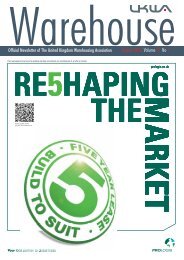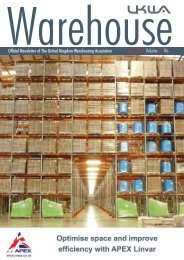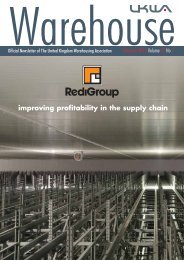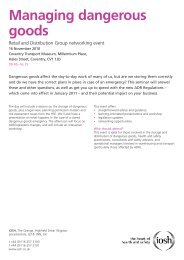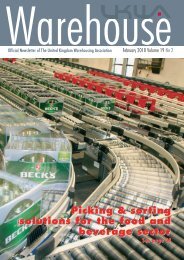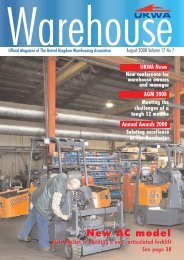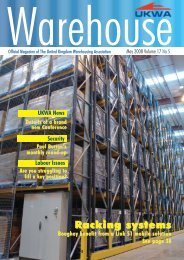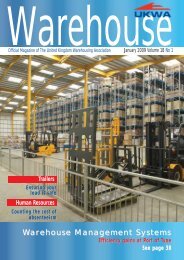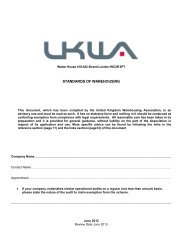34 North AmericaCompeting as aContainer Gateway toNorth AmericaDespite the recent economic downturn North America will remain the major market destination of productsfrom low cost manufacturing countries in Asia for decades to come Garl<strong>and</strong> Chow, PhD, considerskey socio-economic factors <strong>and</strong> business trends affecting the US supply chainNorth America will remain the major marketdestination of products from low costmanufacturing countries in Asia fordecades to come. Despite the recent economicdownturn, every forecast predicts trade fromAsia to resume its growth. The role <strong>and</strong> competitivenessof Port Metro Vancouver (PMV) to efficiently<strong>and</strong> effectively enable Asian products toreach their final destination in North America isone aspect of Port Metro 2050. An underst<strong>and</strong>ingof key socio-economic factors <strong>and</strong> businesstrends affecting off shore trade <strong>and</strong> the supplychain helps build scenarios for strategic planning.PMV competes as a gateway with other NorthAmerican commercial ports in trans-Pacific trade lanes.To more accurately categorize trade patterns <strong>and</strong> theassociated logistics requirements, Asia should bedefined as being comprised of three distinct zones ofproduction: North Asia, South East Asia <strong>and</strong> South Asia.On the North American side, commercial <strong>and</strong> supplyrelations are best distinguished regionally according togeographic sub-sections that include: Northern,Eastern, Southern, Western <strong>and</strong> Central regions.Competitive Position of Pacific Northwest (PNW)Ports <strong>and</strong> PMVThe PNW ports of Seattle, Tacoma (U.S.) <strong>and</strong>Vancouver (Canada) are geographically closer thanLA/LB, to North Asia, the origin of the majority of Asia’sexports. The PNW ports have a sizeable local marketfor Asian produced goods, possess deep water portcapacity, <strong>and</strong> are reasonably close to north <strong>and</strong> centralU.S. Ocean rates <strong>and</strong> schedules do not always reflectthe shorter distance to the PNW ports as more vesselscan completely load or unload in LA/LB resulting inmore frequent direct service. In addition, negotiatedrates for large shippers including freight forwarders areoften equalized across the west coast ports. The PNWports are a good choice for time sensitive freight movingeastward to destinations in the U.S north central(Chicago) <strong>and</strong> U.S. south Central (Memphis). Some ofthe growth in the PNW ports can be attributed to shippersseeking alternatives to the chronic congestion inLA/LB. But as container movement from Asia peaked in2006 <strong>and</strong> 2007, PNW ports have also suffered fromincreasing capacity utilization <strong>and</strong> congestion. The economicdownturn has decreased port usage however,<strong>and</strong> capacity utilization is no longer a significant differentiationfactor between gateway ports at this time.Asian freight exported to Canadian destinations canbe consolidated with U.S. based freight throughAmerican ports. But as Canadian volume increases forthe individual shipper, the shipper may find that directmovement of this freight through Canadian ports couldimprove transit time. U.S. railroad service from U.S.ports lack operations in Central <strong>and</strong> Eastern Canada<strong>and</strong> must interchange with Canadian railroads to enterthat market. This changeover increases transit timewhile also reducing reliability, which is inherent in anyinterchange of equipment between rail lines. In contrast,Canadian railroads have coordinated operationsinto major U.S. hubs <strong>and</strong> markets including Chicago<strong>and</strong> Memphis. Combined, the short ocean transit,seamless rail access to the U.S., comparable l<strong>and</strong> transportation<strong>and</strong> absence of fees such as the HarborMaintenance Tax, improves Canadian gateway competitionfor U.S. bound traffic.Issue No. 3www.warehousinglogisticsinternational.com
North America 35Access to this U.S. heartl<strong>and</strong> is increasingly importantas population <strong>and</strong> industry continues to outperformother geographic sections of the United States. The singlelocation for a distribution centre which would reachthe largest U.S. population was Bloomington, IN <strong>and</strong>now has shifted further south to Henderson, Ky. Themajority of new auto plants are opening in this region.In other words, the U.S. destinations where PNW portsincluding PMV are competitive are growth markets.Inter-port Competitiveness is ultimatelyMeasured by Total <strong>Logistics</strong> Cost of the RoutingLocation gets PMV into the competitive area but theactual freight is delivered by the transportation systemsconnecting origins in Asia <strong>and</strong> the destinations inNorth America. Shippers ultimately choose their routingson based on the door to door logistics costsincurred, the total logistics cost. Total logistics costincludes direct transport costs, inventory costs <strong>and</strong> thecosts of service failure such as stock out, lost sales <strong>and</strong>down time costs. These costs are largely dependent onthe capacity of the transportation <strong>and</strong> logistics infrastructure<strong>and</strong> how well the logistics service providers utilizethat capacity.Thus the following factors must be considered:• Port capacity improvements• Panama Canal expansion• Rail capacity improvements• Highway capacity improvements• Cost recovery fees such as Harbor Maintenance Tax• Shipping line scheduling <strong>and</strong> port strategies (OceanCarrier Service Deployment Strategies)• Transport Chain Management (coordination <strong>and</strong> collaboration)• Labor <strong>and</strong> Union industrial relations environment• Environmental <strong>and</strong> l<strong>and</strong> use constraints• Gateway Related Fees• Security barriersLong Run Competiveness is ultimately determinedby Origin <strong>and</strong> Destination of TrafficShifting trade patterns may be more significant thanthe initiatives of gateway competitors in determiningthe competitiveness of an individual gateway <strong>and</strong> corridor.This is because; the Asia Pacific GatewayCorridor’s (APGC) location advantage is positioned forfreight originating in North <strong>and</strong> South East Asia tonorthern <strong>and</strong> central North America. If freight growthshifts to other origin–destination trade corridors, theAPGC is disadvantaged in receiving North Americanimports due to its location.Some of the key factors that are going to affectwhere products will be produced for import into NorthAmerica are:• wage rates• exchange rates• fuel/transportation costs.• Export subsidies (China VAT rebate)• Internalization of carbon emission externalities as abusiness cost.• Dem<strong>and</strong> driven supply chain strategyIn fact, the convergence of the first four factors hasresulted in the Total L<strong>and</strong>ed Cost of producing selectedproducts in Mexico <strong>and</strong> delivering to the U.S. marketlower then manufacturing in China <strong>and</strong> for other products,lower in India or other South Asian countries thanin China (see box). For the foreseeable future, perhapsmany decades, China will remain the overall low costwww.warehousinglogisticsinternational.comIssue No.3




